Comets – How to Discover them - Part2
steemstem·@terrylovejoy·
0.000 HBDComets – How to Discover them - Part2
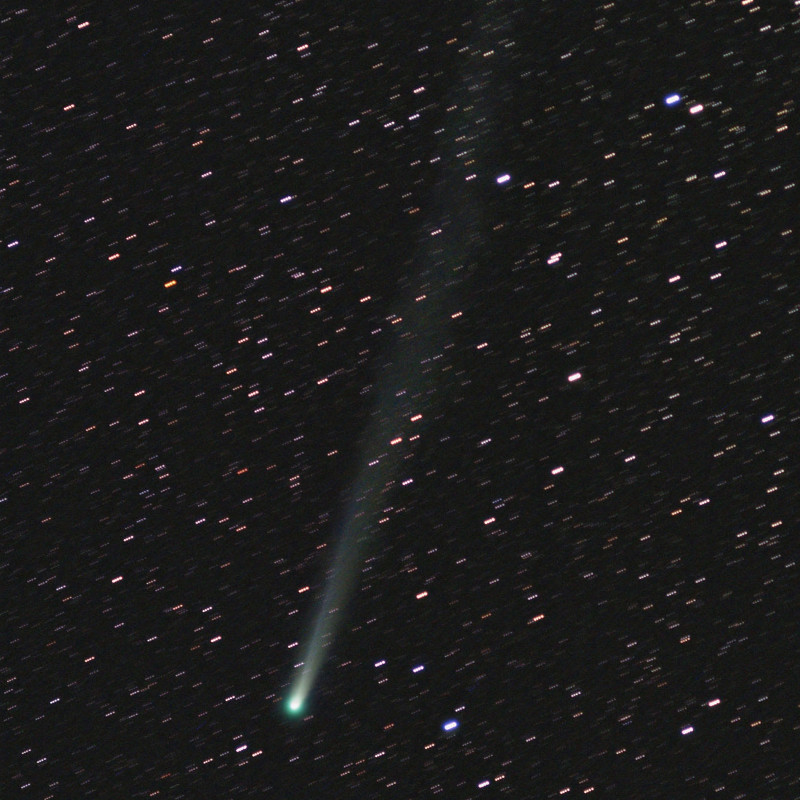 *Comet C/2013 R1 (Lovejoy) on December 6, 2013. Click Image to see the [full image on Rolando’s gallery site]( https://www.astrobin.com/67089 ). Image Credit: Rolando Ligustri* In [Part 1 of this article](https://steemit.com/steemstem/@terrylovejoy/comets-how-to-discover-them-part-i), I spoke about how I developed a system for finding comet’s as well discussing the circumstances around the discoveries of the first 3 Lovejoy comets. In this part I talk about the successes I’ve had with automated detection of comets. ## Implementing Automated Detection In 2013 I stopped scanning each image manually and instead started using an auto detection process. I originally set out to find a program that could so this, and at the time could not find something that I was happy with. Here I will discuss my approach using a custom program that uses the freely available Source Extractor program to perform the “heavy lifting” process of cataloging images. #### Cataloging the Images The first step in automated detection is to catalog the image, which is the process of turning the image into a table of objects with properties such as position, size and brightness recorded. A list of objects is a lot easier for a computer to deal with than the raw images. This is illustrated in the following diagram, where the right hand pane is the graphical representation of the catalog generated from the image. 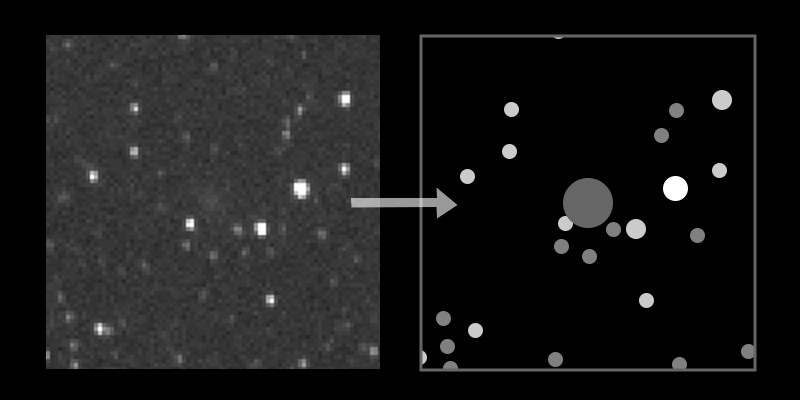 *A raw image, on the left, is converted to a catalog on the right* #### Matching (Removing static objects) When comparing 2 successive images the first step is to identify all the static common objects (eg stars and galaxies) in both images and eliminate them leaving just changed objects. Here is an example of 2 successive images that happen to contain a faint comet. The images are first cataloged as shown: 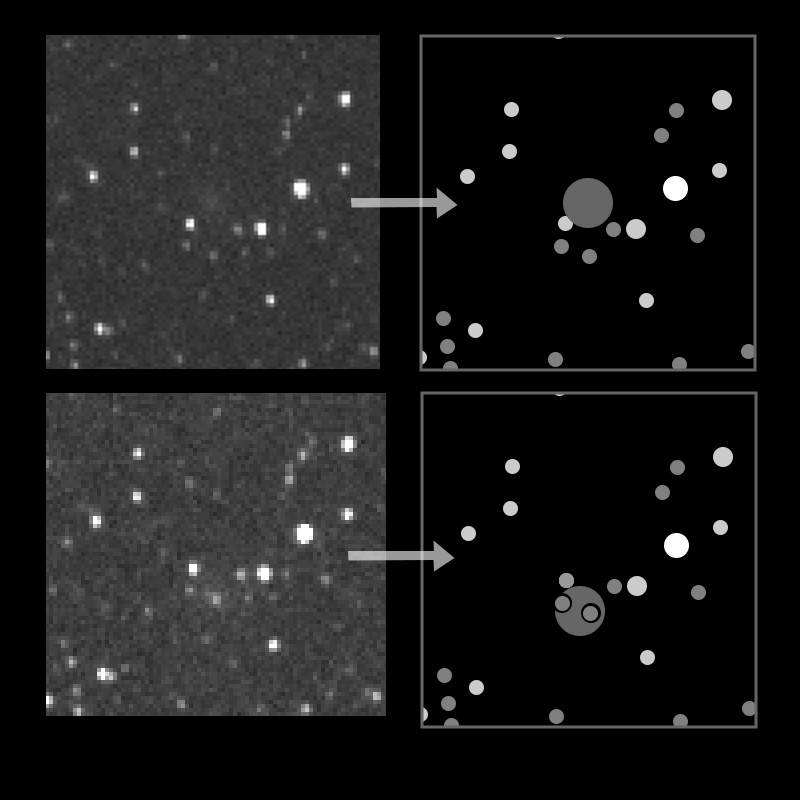 *2 successive images are cataloged, note there is a very faint diffuse comet that moves between the images, represented by the large grey disk in the the cataloged image on the right* Then the common static objects are identified and removed (marked red in the following image) leaving just a catalog of changed objects such as comets, asteroids, cosmic ray strikes and noise for both images. In this example we have just a single changed object, which is the comet shown and its shown as the grey disk. 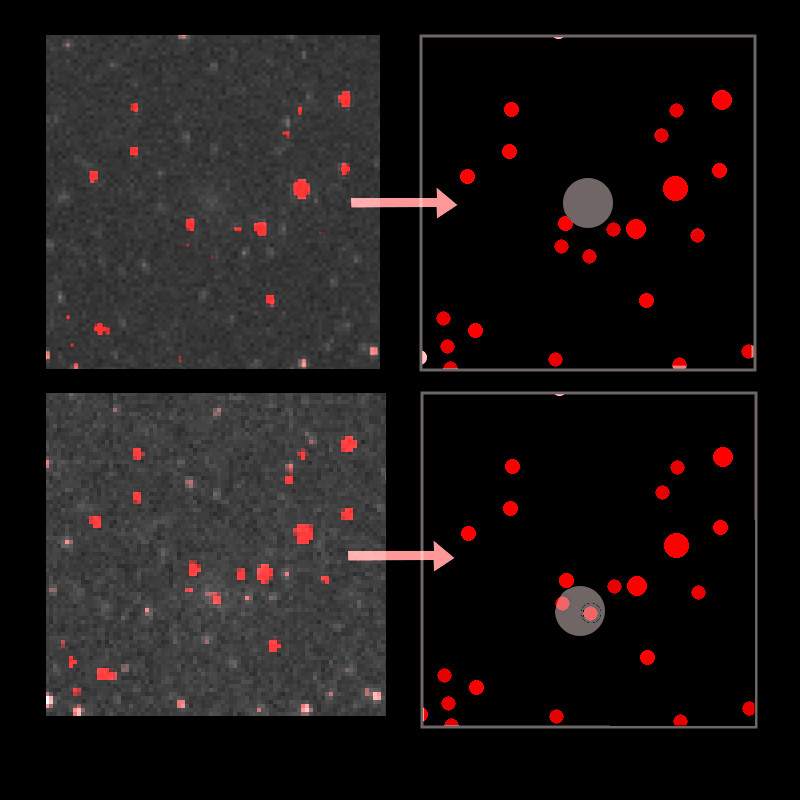 *All objects identified the same are marked in red, the comet which has moved cannot be matched and is marked grey* In the remaining list of changed objects it is then necessary to do some further checks which establish whether the object is transient (like a cosmic ray strike) or whether there is object that has moved (like a comet). This is really all there is to the process, although it sounds simple it is more complex because of several practical problems such as blending and noise which I will discuss shortly. However, I have tuned my program to the point it greatly reduces the amount of work to manually find comets, and it has been proven to work by finding 3 comets (C/2013 R1, C/2014 Q2 and C/2017 E4). ## Practical Problems There are a lot of practical issues with cataloging images, the major ones being noise (causing statistical uncertainty in position, brightness and size) and blending. #### Deblending Blending is where objects overlap with one another and the computer algorithm can have difficulty deciding whether there is a single object or multiple objects in a catalogue detection. An example of this is visible in this example where 2 faint stars are superimposed on a diffuse comet. 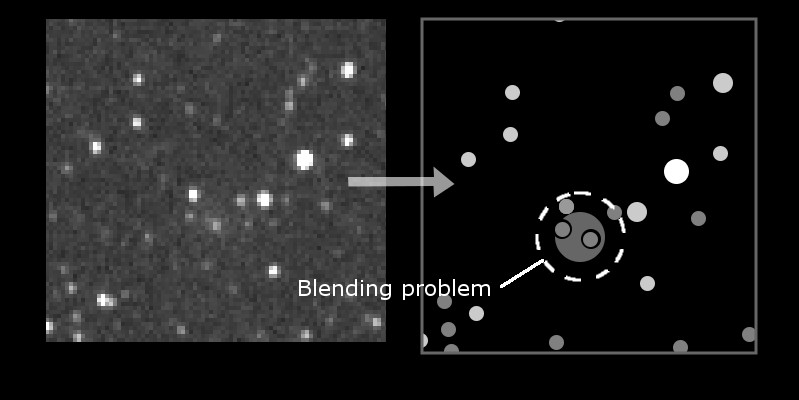 *Blending problem where a large faint diffuse object (comet) is overlayed with 2 stars as shown* Luckily the problem of Blending is dealt with well with an open source product called “Source Extractor”. Although it’s been around since the 1990’s this is still an effective program and works well with real images. #### Noise Statistical noise in an image (because of camera as well as photon statistical behaviour) introduces problems that cannot be removed by a computer algorithm but must be considered when detections are done. For instance, when Matching 2 objects in a ideal situation we could say: *If (Object1 Properties - Object2 Properties) == 0, then Object1 is Object2* However, in real images the comparison is really: *If (Object1 Properties - Object2 Properties) < Error Threshold, then Object1 is Object2* The Error Threshold needs to be computed from the signal to noise of the object being compared. ## Successes with Automated Discovery So far, I have had 3 successes (although I have not been actively searching for over 10 months). Here is some quick information about each discovery. #### Comet C/2013 R1 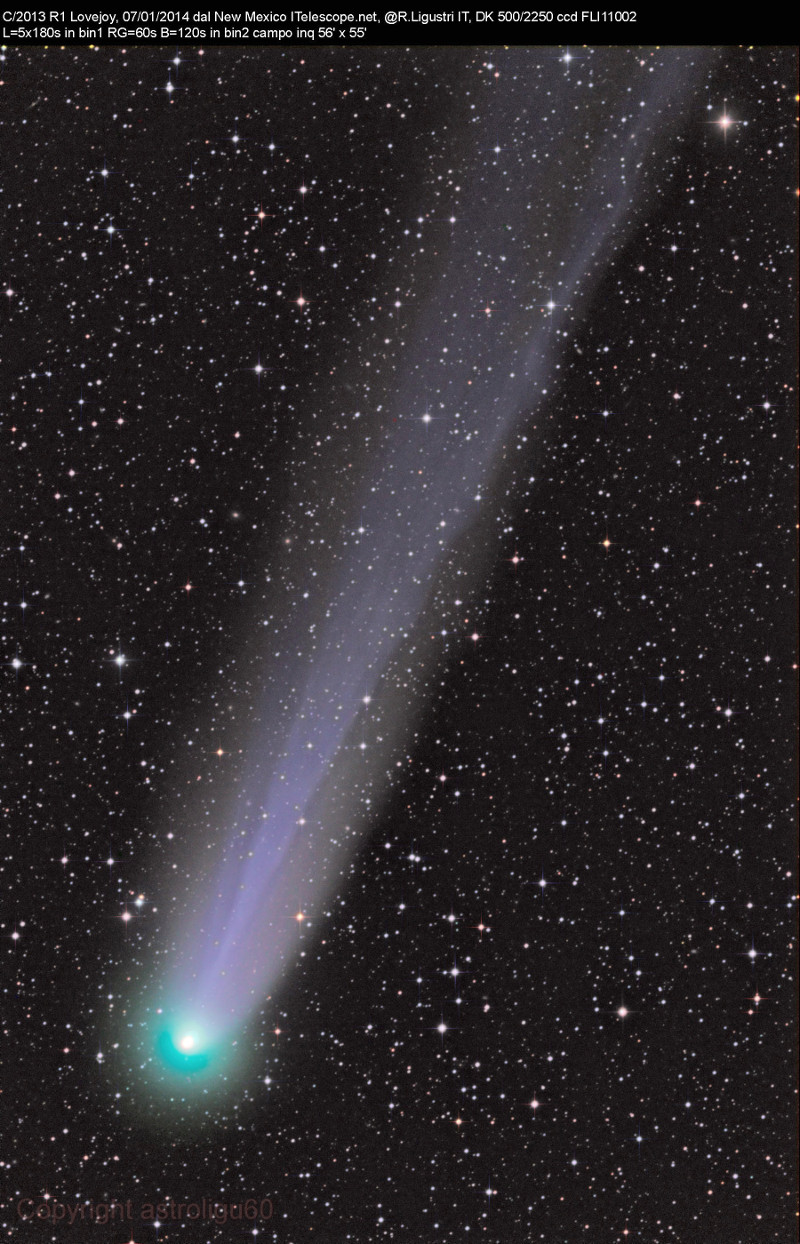 *Comet C/2013 R1 (Lovejoy) on January 7, 2014. Click Image to see the [full image on Rolando’s gallery site](https://www.astrobin.com/71553). Image Credit: Rolando Ligustri* Comet C/2013 R1 was discovered in 3 images from a run of 675 images I made on the morning of September 7, 2013. Around Christmas, 2013 It did indeed brighten, develop a nice tail, and for people well away from city light it could even be glimpsed with the unaided eye at its best. #### Comet C/2014 Q2 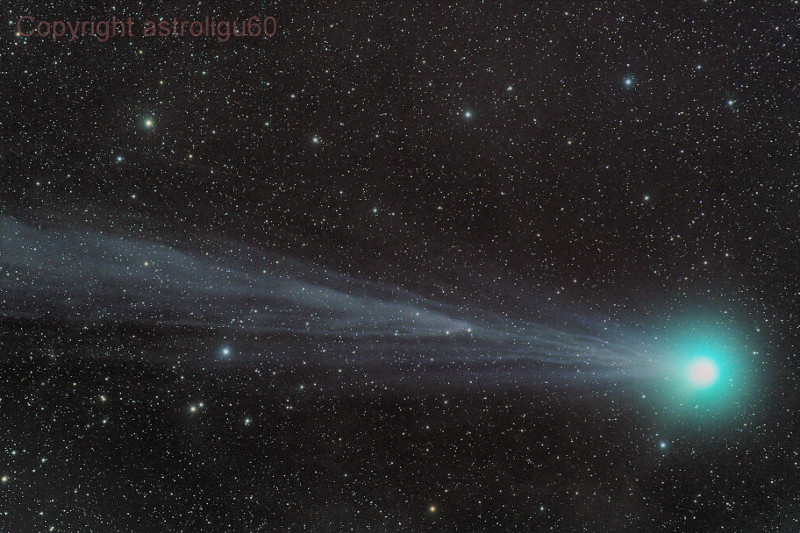 *Comet C/2014 Q2 (Lovejoy) on January 15, 2015. Click Image to see the [full image on Rolando’s gallery site]( https://www.astrobin.com/148585 ). Image Credit: Rolando Ligustri* Comet C/2014 Q2, was found in the constellation of Puppis on the morning of August 17, 2014. Orbit calculations indicated a perihelion on January 30, 2015, at 1.3 Astronomical units which meant the comet barely got closer to the sun than the planet Mars. Initially, the comet was expected to remain faint but it brightened a lot faster than expected so that by January, 2015, it could be seen with the naked eye. #### Comet C/2017 E4 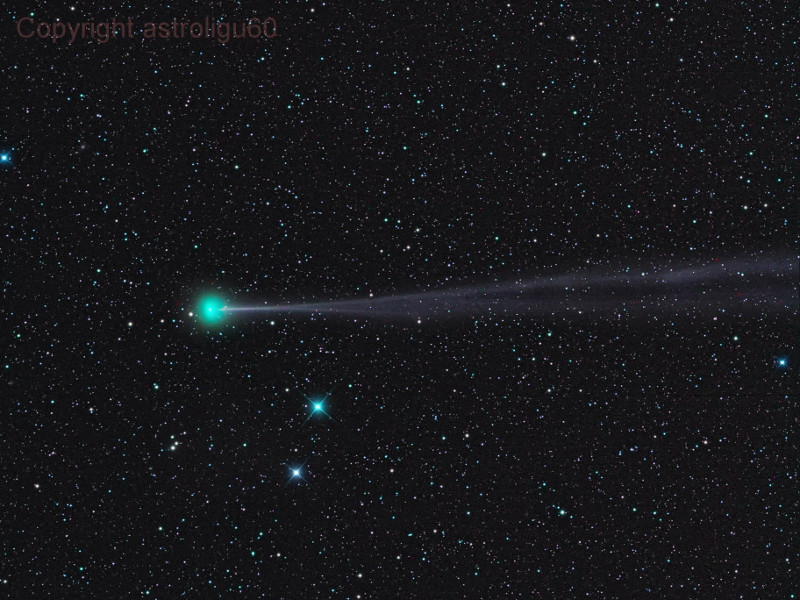 *Comet C/2017 E4 (Lovejoy) on April 4, 2017. Click Image to see the [full image on Rolando’s gallery site]( https://www.astrobin.com/148585 ). Image Credit: Rolando Ligustri* Comet C/2017 E4 (Lovejoy) was found on March 9, 2017. It did get bright enough to see in binoculars but did not survive much past perihelion which was at the end of April, 2017. ## Reporting a Comet Discovery How does a comet discovery get reported is one of the question’s I get asked? The process is a multi step process as outlined here: #|Process -|- 1|Obtain accurate times and positions of object in all images. A program like [Astrometica]( http://www.astrometrica.at/ ) is almost essential for this type of work 2|Check for false positives, is it a lens reflection from a bright star, galaxy, etc? 3|Check for known objects. This could be an existing comet/asteroid. Check against [Minor Planet Checker]( https://www.minorplanetcenter.net/cgi-bin/checkmp.cgi) 4|If steps 1-3 passed, notify other people capable of doing follow-up observations of object. 5|If confirmation by other people successful, email positions in correct format to Minor Planet Center (non-trivial unless you have the right software like Astrometrica!). 6|Notify by email [Central Bureau for Astronomical Telegrams]( http://www.cbat.eps.harvard.edu/) (CBAT) of discovery and reference to the Minor Planet Center positions. 7|Wait…the discovery should appear on the [Possible Comet Confirmation Page]( https://minorplanetcenter.info/iau/NEO/pccp_tabular.html) in a few hours 8|Others will see the post on the [Possible Comet Confirmation Page]( https://minorplanetcenter.info/iau/NEO/pccp_tabular.html) and more observations will come in. 9|Within 2-3 days sufficient observations are usually received to calculate a good orbit. This establishes whether this is truly new discovery or whether it is an old comet that has been discovered before. 10|An official announcement is made from both CBAT and the Minor Planet Center. These organisations have been delegated by the International Astronomy Union to name new astronomical objects. 11|If 1-10 all check out, congratulations you are the discoverer of a new comet! ## Why comets? I was always fascinated with astronomy and photography from a young age. As a child growing up in the 1970’s the space race and moon landings, as well as the first planetary missions also contributed to my enthusiasm. What struck me however my grandmothers and father’s tales (no pun intended!) of bright comets they had seen when they were a lot younger. My grandmother, born in 1903, had remembered seeing Halley’s Comet during the very favourable 1910 return when it was a striking comet in the morning sky. Her description of how the comet dominated the sky from her home near Moss Vale, South of Sydney, really peaked my interest. At the time we had very few books on astronomy, but we did have David Bergamini’s book “The Universe (Life Nature Library)” which among its many inspirational photos contained this photo of Halley’s Comet in 1910. 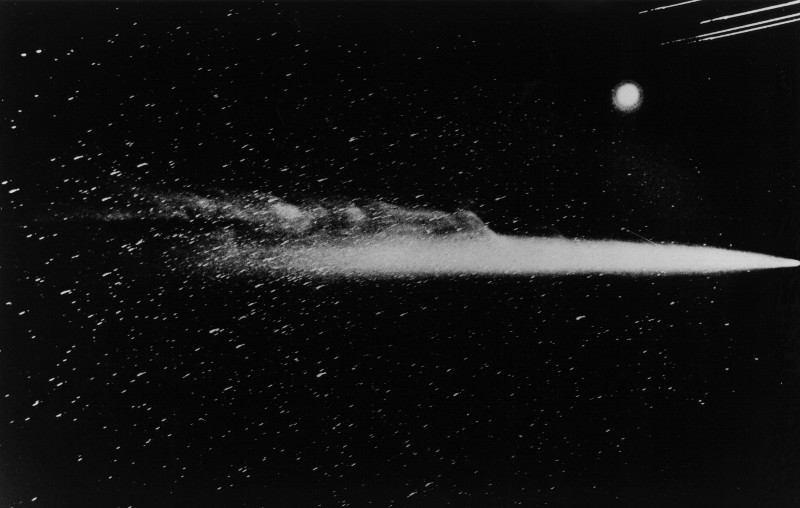 *Halley’s Comet May 13, 1910 from Lowell Observatory. The planet Venus is at top, and the constellation of Pegasus is under the comet. Image Credit: Lowell Observatory* ## Conclusion This is the final part of "Comets - How to Discover them". I hope readers enjoyed following my journey in building a system to discover comets! ## References 1. Bertin, E.; Arnouts, S. (1996) SExtractor: Software for source extraction. Astronomy and Astrophysics Supplement, v.117, p.393-404
👍 keephy, grisotti, centerlink, mikepedro, webcoop, cryptwo, choogirl, teamaustralia, ausbitbank, spiry-btc, chasmic-cosm, vinamra, proteus-h, betelzeus, bloom, terrylovejoy, jagarmarten, steemstem, dna-replication, curie, locikll, cryptokrieg, ewuoso, jasimg, xanderslee, skaybliss, chemistry0, sikan-eyen, tantawi, steemanator, aboutyourbiz, howtostartablog, fujiwara, tradeownsystems, birgitt, spectrums, shaff.aff, suzayn17, askeb, ivan.atman, bimijay, snowgoat, hendrikdegrote, life.goals, alfa-good, legendarryll, solomonogene, awolesigideon, votetanding, speaklife, randomwanderings, binarycounter, euguma, kid1412, vanj, jerscoguth, anwenbaumeister, mseuno, karyah1001, esaia.mystic, wanderingdanish, sephirods, ligarayk, babaj, beanenergy, kamilala125, squares, kimp0gi, hoobeehey, luca21, medical-hall, eightbitfiction, gordispro, shawnycx, befaro, pichat, tensor, mike314-0005, khalidjr11, crescendoofpeace, kul0tzzz, zipporah, kushed, anarchyhasnogods, lemouth, steemstem-bot, justtryme90, mobbs, the-devil, foundation, lamouthe, rachelsmantra, nitesh9, kerriknox, gra, rockeynayak, rjbauer85, kryzsec, sci-guy, amavi, dber, gentleshaid, mystifact, kenadis, carloserp-2000, hadji, fredrikaa, leczy, altherion, juanjdiaz89, sanja-cash, salvadorcrg, jibril14, steemulator, jaeydallah, gohba.handcrafts, marianaceleste, kingingodwin, tanvirrahman, delph-in-holland, sinbad989, sillentkiller, srajsoftware, mrfrancis, daemon-nice, zest, firipinjin, intuitivelearner, cengizhan61, juicy-shark, ovij,